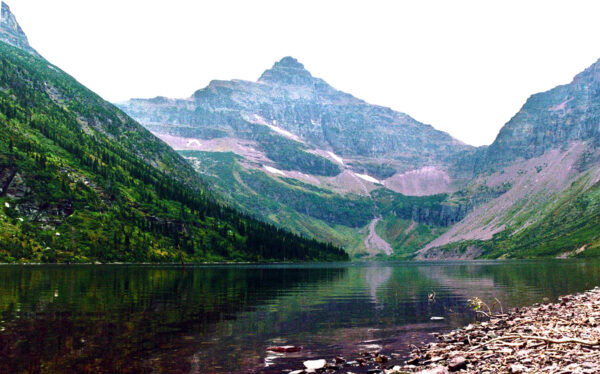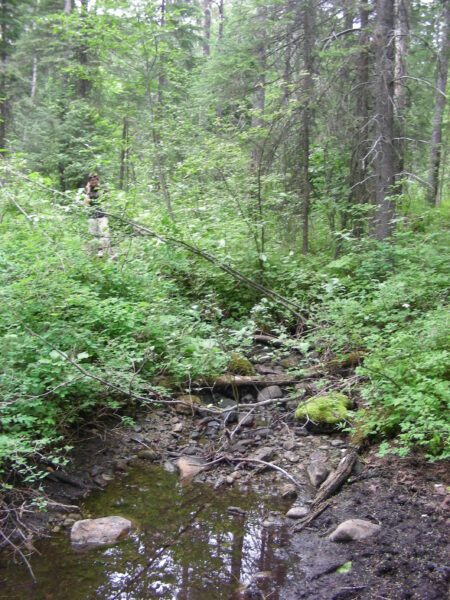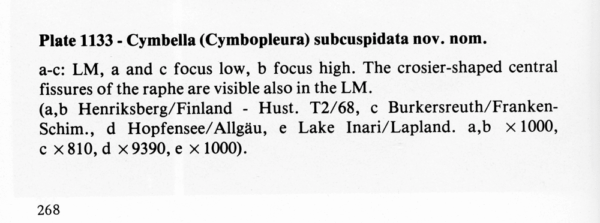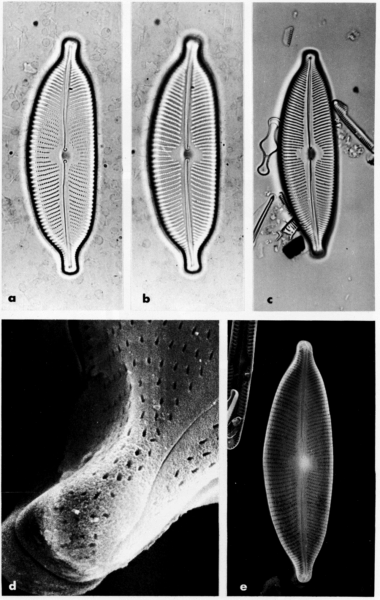Cymbopleura subcuspidata
-
Category
-
Length Range67-111 µm
-
Width Range19-25 µm
-
Striae in 10 µm9-12 (dorsal and ventral) at the valve center; 12-15 (dorsal) and 13-16 (ventral) at the apices
-
ContributorLoren Bahls - Aug 2012
-
ReviewerSam Rushforth - Sep 2012
Identification
Description
Valves are elliptic-lanceolate and slightly dorsiventral with almost equally arched dorsal and ventral margins that taper towards bluntly rounded rostrate to subcapitate apices. The length to width ratio is 3.3-4.4. The moderately narrow axial area widens gradually from the apices towards a large rounded and asymmetric central area. The raphe is lateral and narrows towards the distal and proximal ends. Proximal raphe ends are deflected ventrally and shaped like a crochet hook or a crosier. Terminal raphe fissures are deflected dorsally. Striae are radiate throughout and more closely spaced towards the apices. Areolae are easily resolved in LM and number 19-22 in 10 µm.
Autecology
Cymbopleura subcuspidata occurs frequently in lakes and ponds in the northern Rocky Mountains. Concurrent measurements of pH in waters where C. subcuspidata has been collected range from 6.73 to 7.78. Specific conductance in these waters ranges from 22 to 53 µS/cm.
-
Size Range, µm3
-
Motility
-
Attachment
-
Habitat
-
Colony
-
Waterbody
-
Distribution
- Learn more about this
Citations & Links
Citations
Links
-
Index Nominum Algarum
-
GenBank
-
North American Diatom Ecological DatabaseNADED ID: 190007
Cite This Page
Bahls, L. (2012). Cymbopleura subcuspidata. In Diatoms of North America. Retrieved November 21, 2024, from https://diatoms.org/species/cymbopleura_subcuspidata
Responses
The 15 response plots show an environmental variable (x axis) against the relative abundance (y axis) of Cymbopleura subcuspidata from all the stream reaches where it was present. Note that the relative abundance scale is the same on each plot. Explanation of each environmental variable and units are as follows:
ELEVATION = stream reach elevation (meters)
STRAHLER = distribution plot of the Strahler Stream Order
SLOPE = stream reach gradient (degrees)
W1_HALL = an index that is a measure of streamside (riparian) human activity that ranges from 0 - 10, with a value of 0 indicating of minimal disturbance to a value of 10 indicating severe disturbance.
PHSTVL = pH measured in a sealed syringe sample (pH units)
log_COND = log concentration of specific conductivity (µS/cm)
log_PTL = log concentration of total phosphorus (µg/L)
log_NO3 = log concentration of nitrate (µeq/L)
log_DOC = log concentration of dissolved organic carbon (mg/L)
log_SIO2 = log concentration of silicon (mg/L)
log_NA = log concentration of sodium (µeq/L)
log_HCO3 = log concentration of the bicarbonate ion (µeq/L)
EMBED = percent of the stream substrate that is embedded by sand and fine sediment
log_TURBIDITY = log of turbidity, a measure of cloudiness of water, in nephelometric turbidity units (NTU).
DISTOT = an index of total human disturbance in the watershed that ranges from 1 - 100, with a value of 0 indicating of minimal disturbance to a value of 100 indicating severe disturbance.
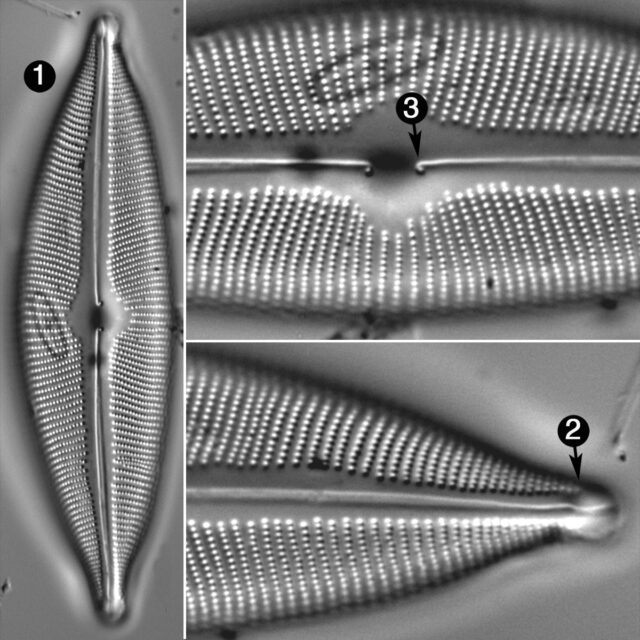
Cymbopleura subcuspidata
- Valves >50 µm long, length/width ratio 3.3-4.4
- Apices rostrate to subcapitate and bluntly rounded
- Proximal raphe ends shaped like crochet hooks or crosiers
Cymbopleura subcuspidata has elliptic-lanceolate valves that are more than 50 µm long and with a length-to-width ratio of 3.3-4.4. The apices are rostrate to subcapitate and bluntly rounded. Proximal raphe ends are shaped like crochet hooks.
 Diatoms of North America
Diatoms of North America




